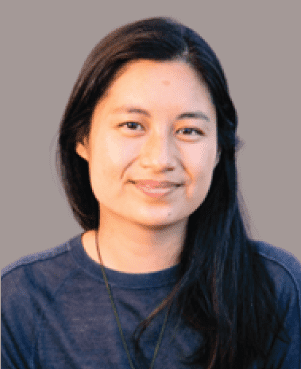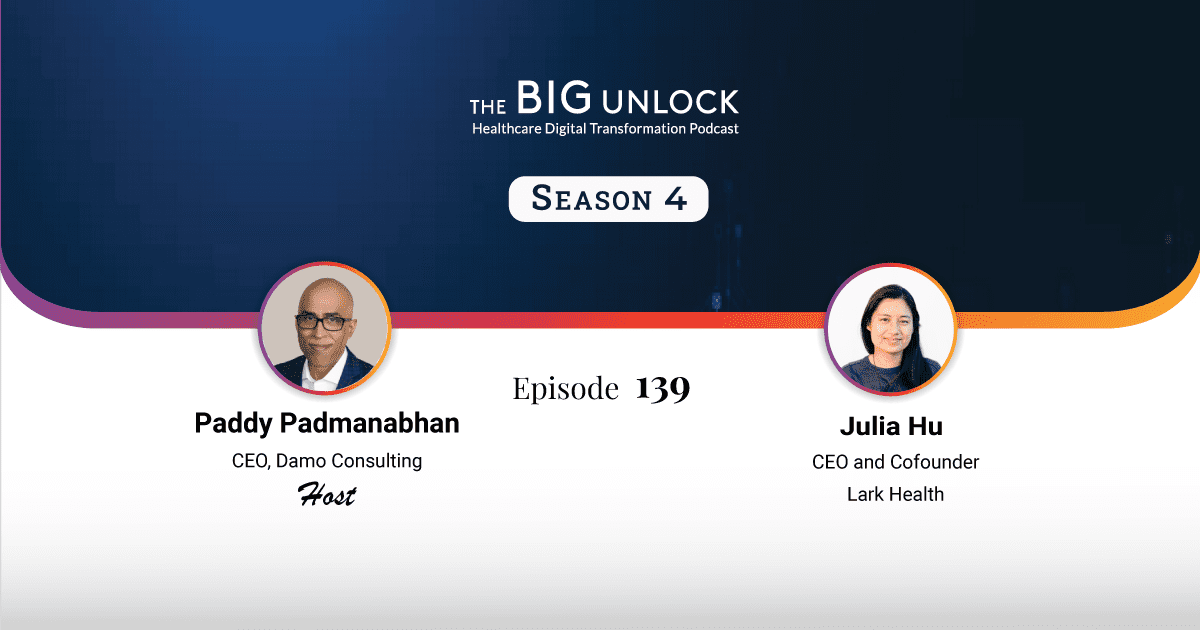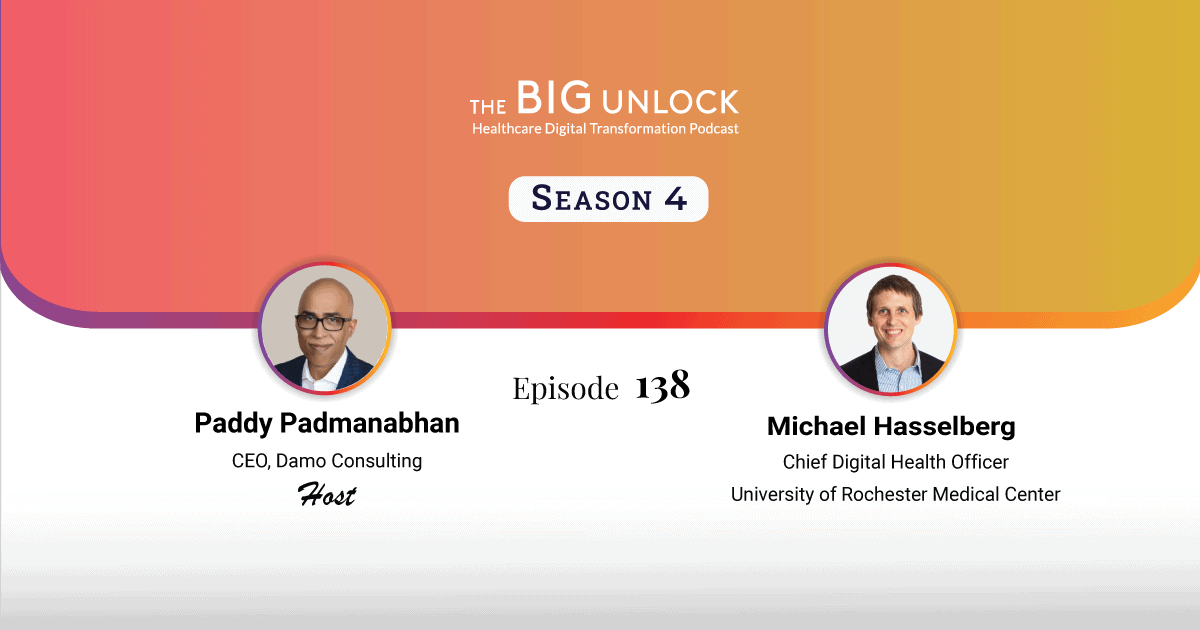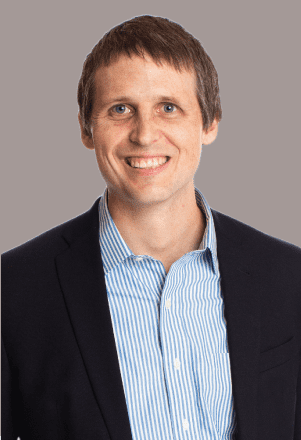Season 4: Episode #139
Podcast with Julia Hu, CEO and Cofounder, Lark Health
"Healthcare is the last industry that hasn’t yet been truly revolutionized and disrupted by technology"
 Hosted by Paddy Padmanabhan
Hosted by Paddy Padmanabhan 
Share
In this episode, Julia Hu, Founder & CEO of Lark Health, a leading AI virtual healthcare counseling platform, is helping nearly 2 million people manage and prevent chronic conditions, stress, and anxiety. Having invested more than $100 million in R&D, Lark combines cutting-edge AI with remote patient monitoring capabilities to provide 24/7, real-time, text message-based health counseling to patients whenever and wherever they need it.
Julia explains how their text message-based counseling platform is clinically equivalent to live nurse care management services. She also talks about how virtual and at-home care delivery has been impacted by the supply and demand curve, the digital health startup ecosystem, and their new partnership with Salesforce to expand into the “payvider” segment of healthcare. Take a listen.
Show Notes |
||||
| 01:21 | Julia, can you talk us through how you got to starting the company and some of your personal journeys that have led you to where you are. | |||
| 03:40 | What kind of conditions do you address using your approach and your platform? | |||
| 04:53 | How is your remote and AI enabled care different? | |||
| 06:42 | Can you explain the term clinical equivalence? | |||
| 09:15 | How has the pandemic impacted your demand environment? | |||
| 12:20 | This year, apart from all the macro factors, inflation, and interest rates, the VC funding environment has contracted a little bit. What does that mean for you and for the digital health startup ecosystem? | |||
| 15:37 | You've done some interesting partnerships, especially one with Salesforce. Can you talk about that? | |||
| 18:03 | What is your advice for startups founders, those who have either recently come into the market with a product and they're finding themselves facing headwinds because of the macro environment or those who are looking to get into digital health right now. | |||
| 19:39 | Julia, you mentioned “payviders” and this is a very interesting segment which is quite different from the normal payer-provider dynamic. Talk to us a little bit about that and why you mentioned that segment as a focus area for your company. | |||
| 21:58 | You mentioned early on that you're working mostly with health plans and with employers. Could this potentially be your opportunity to expand into the provider? | |||
About our guest

Julia Hu is an entrepreneur and co-founder and CEO of Lark Health. Founded on the personal experience of living with an undiagnosed chronic condition, Julia is passionate about bringing compassionate care to those preventing or managing chronic disease. Named "10 Most Innovative Apps'' alongside Uber and Airbnb, Lark’s trailblazing A.I. platform allows payers to offer an unlimited, one-on-one chronic disease prevention experience to all patients and is a covered medical benefit offered by many health plans.
Hu was named on the Business Insider’s 30 Under 40 Changing Healthcare list and was awarded as a member of the UCSF Health Awards Hall of Fame in 2021, as well as the EY Entrepreneurial Winning Women™ North America Class of 2021.

Julia Hu is an entrepreneur and co-founder and CEO of Lark Health. Founded on the personal experience of living with an undiagnosed chronic condition, Julia is passionate about bringing compassionate care to those preventing or managing chronic disease. Named "10 Most Innovative Apps'' alongside Uber and Airbnb, Lark’s trailblazing A.I. platform allows payers to offer an unlimited, one-on-one chronic disease prevention experience to all patients and is a covered medical benefit offered by many health plans.
Hu was named on the Business Insider’s 30 Under 40 Changing Healthcare list and was awarded as a member of the UCSF Health Awards Hall of Fame in 2021, as well as the EY Entrepreneurial Winning Women™ North America Class of 2021.
Before founding Lark, Julia ran a global startup incubator, the CleanTech Open, that built a sustainable construction startup, and was an Entrepreneur-in-Residence at Stanford’s StartX incubator. She sits on the board of the Council for Diabetes Prevention and is an active Singularity University faculty member. Hu received her Master’s and Bachelor’s degrees at Stanford University and half of an MBA from MIT Sloan before founding Lark.
Q. Julia, you have a very interesting personal story for how you started Lark Health. Do share that and tell us about your personal journey that led you to where you are.
Julia: It’s certainly been a journey and one that started when I was a child. I’m not a doctor. I have no clinical background, but I am a deep consumer of health care. Ever since I was a little kid, I had many different chronic and autoimmune conditions. They were all undiagnosed but left me pretty sick as a child. My dad had to quit his day job to take care of me. After visiting dozens of doctors, he found this Pediatrician for me and it was like my 24*7 care team — my pediatrician, my dad and I. Over 12 years on this journey where my pediatrician would completely change my diet and help me manage pain, exercise, sleep, medication, and stress, I found that it really changed my life. I got rid of 90% of my attacks, even though I didn’t know what I had as a condition or a series of conditions. That’s what really changed the way that I saw medicine. I felt that if you could treat the whole person and provide 24*7 personal, compassionate care, you could really do a lot to change people’s lives.
Fast forward to me as an adult, I saw that there were not enough doctors and nurses and the ones there were so overworked. How then could you really create this unlimited infinitely scalable care, especially focused on people struggling with chronic conditions or health issues that could lead to chronic conditions or mental health struggles?
As a tech entrepreneur, we decided to tackle this very big problem of using AI and remote patient monitoring, behavioral health, and cognitive behavioral therapy — How do you use these tools and technologies to infinitely scale virtual care? That’s how Lark was born.
Q. What kind of conditions do you address using your approach and your platform?
Julia: Think of our platform as 24*7 text message-based counseling, plus all of the remote patient monitoring. The devices that someone might need, whether they have diabetes, hypertension, pre-diabetes, stress and anxiety, or they just want to sleep better or stop smoking – we cover about ten conditions in preventative, chronic and mental health. We treat about two million patients on our platform and our health plans manage 30 million lives right now for one of these ten conditions.
Q. Are your main customers health plans?
Julia: Yes. We also have about a thousand employers that we work with. We’re also actually just starting to work with pharma companies as well.
Q. Remote care, AI enabled care has been around and there’re a lot of companies that are taking a similar approach to remote care. How is yours specifically different? Is it the cognitive behavioral aspect or the tech?
Julia: Most of population health, today, is what I would call either health care services or tech-enabled health care services, which means you have a care manager, or a nurse and they get on a phone call with you or, they do a webinar with you or, you go in-person to a doctor to get a care plan. That obviously has scale and cost constraints.
What we do is we try to say, “Okay, what if you could automate this first line of defense and turn it essentially into an AI chatbot?” We spent about seven years, $100 million in R&D and trained our AI on about a million patients. It started getting clinical equivalents to live nurses. That’s how we started scaling our services. That’s also why we’re able to manage more than 2 million folks through all this tech and automation.
Now, the tech and automation are not just the devices, the hardware and remote patient monitoring. Also think of us as a friend. We’re there at 1 a.m. If you need to text when you’re feeling stressed, we’ll do a five-minute meditation session with you. When you’re a diabetic and you have some increases in glucose, we will help you understand what you ate that triggered that. So, we’re really all about using the best of cognitive behavioral therapy, the best of the care plans, and providing care in an easy to digest way.
Q. You mentioned the term “clinical equivalence.” What does it mean?
Julia: What we’ve done is, shown that just with our AI text message-based counseling, we can have equivalent outcomes to live nurse care management type services. So, everything from — we’re seeing one-point a1c average drop for diabetics, we’re seeing 13 points drop on hypertensive, and we are, for example, CDC fully recognized as a DPP provider. CDC does a longitudinal look at 2400 providers, and we are in the top 25% of those providers.
We’ve been able to show that our outcomes are just as good. But because we are AI and not taking up and using all these nurses and coaches, we’re able to be much more scalable and deliver care at much lower the cost.
Q. Do you in commercial terms offer these kinds of assurances to your clients — health plans — and really take risk and participate in the rewards and the gains based on this experience?
Julia: Yes, we do. That’s why we do performance-based pricing. We only get paid if we hit certain clinical thresholds and if we engage patients. So, we have that — PMPM and performance guarantees. We really try to ensure that we put our money where our mouth is.
Q. In the last couple of years, we had the pandemic and within that, behavioral health and mental health was a big pandemic. The other big forcing function more recently has been the shortage of labor. How has that impacted your demand environment and your own business in terms of these macro level factors?
Julia: I think that the pandemic has really changed everything. However, specifically the silver lining to the pandemic in my mind, is that healthcare has been the last industry that hasn’t yet been truly revolutionized and disrupted by technology.
I do feel that the pandemic has pushed us probably up a whole generation on unlocking some of that innovation for us. With regard to our managed members, we went from one to 30 million for our health plans. We went from a ragtag team of engineers and tech and data AI folks and raised about $160 million during the pandemic and scaled our team close to 500%.
So, we do feel very excited that we’ve been able to participate because virtual care and getting care delivered through your phone, wherever you are or safe in your own home, are things that really started shifting with supply and demand. It’s been a real learning curve.
Now that the pandemic is in a much better place, people want to stay here. They want to get convenient and cheaper access to care when they want it, when they need it. They want consumer care now rather than health care being very non consumer-centric. In those ways, we’ve been a beneficiary of the acceleration toward digital innovation.
But of course, we have also had to struggle with building a completely remote workforce and creating the culture to align teams. We have not been immune to this recession that’s looming, and I’m just very grateful, though, that we’ve been really pushing forward and had a good growth spurt.
Q. The last couple years were good for fundraising, especially for later stage startups that had demonstrated some degree of traction, stability and growth potential. But things have changed a little in the second half of this year. There’re the macro factors — inflation and interest rates, and the VC funding environment has contracted a little bit. What has that meant for you and the digital health startup ecosystem?
Julia: It’s so interesting. You and I were just talking about the health conference that came out and I was so shocked at how many hundreds of vendors and new digital innovations in the exhibit halls, there were.
I do think that the funding has really pushed forward a ton of innovation. And with the recession coming and the big draw-back of capital funds available now, you have a lot of new companies needing to essentially get toward a go to market strategy, a product market fit, get to more profitability and revenue much more quickly. There is going to be some bumpiness. There is definitely going to be consolidation in the market, a lot of point solutions getting deals here or there that are pretty young and so, the partners on the employer side, on the health system side, on the health plan side might also experience some bumpiness as they work with very innovative but very potentially new and young companies that hopefully, get through the Winter.
However, I think it’s our job — not just of the young companies, in fact all of us growth companies, and the newly public companies — to be good stewards of the capital in our coffers, to really focus on the core business, drop and deprioritize some fun experiments and R&D efforts and really just lean into the focus areas.
Q. One of the things that I’ve learned as an entrepreneur is it’s just as important what you choose not to do as it is to decide what you choose to do. Your comments about the funding environment and what it means for startups that have sort of overextended themselves is true and we’ve seen examples in the behavioral health space with companies indulging in a culling of the herd. Is the recession you mention twice above, a given based on everything that you’re saying or are we probably already in one and we just don’t know it?
Julia: I am not an economist. I don’t know enough about the markets. However, I feel like we need to be very honest with ourselves. We are in the beginnings of winter. I don’t think that winter will be over, immediately. I hope for the best, but I also plan for a more serious winter.
Q. You’ve done some interesting partnerships, especially one with Salesforce. Do tell us about that.
Julia: We were just at Dreamforce with the Chief Customer Officer and the Chief Health Officer launching our products partnership that we created a tech stack with Salesforce. It’s very exciting because here we’ve been able to bring together two parts of the tech stack that serve the marketplace.
Salesforce is very good with being a market leader in CRM and essentially with a data infrastructure and tool kit for everything on the marketing side as well as now for the clinical workforce — the pharmacists, the care managers, the telehealth providers providing data to them through a clinical CRM — so that they can perform at the top of their license. Salesforce came to us and said, “Hey, we’ve got this market leading product. Now, what we do need is a way and a technology to really mass acquire members and patients — to engage them, triage them into virtual care plans, and then, to be the front line of defense for care and at the right time, escalate them to nurses, care managers, providers, ensuring that they get the clinical data so that they can perform at the top of their license.”
That was our exciting partnership — this idea of we being the B2C and they, being the B2B platforms and us cross-selling that into health plans, providers, value based care providers and pharma etc.
Q. It looks like 2023 will be a difficult year. What’s your advice for other founders startups who have either recently come into the market with a product and are now facing headwinds because of the macro environment? Or those who are looking to get into digital health right now and have a nice idea. What’s your advice to them?
Julia: I think you gave great advice — Hold on to that cash.
I think that focus would probably be my advice. Just focus on where your strengths are. Be very honest with yourself, on what your strengths are and where you’re weak. Focus on those strengths and leveraging how do you lean into those strengths to leverage them even more.
For us, I keep telling my team our two strengths are we have a cost advantage and we have a scale advantage. Where do we lean in to, to really where that matters? Where we have a cost sensitive client.
You’d say “Oh! All clients are cost sensitive.” But in fact, we found a lot of interest and scaling in value-based care partners in fully insured. We power many fully insured book of business for health plans. We power Medicare and Medicaid. It’s these types of things, really leaning into your strengths and just being very focused.
Q. So Julia, you mentioned payviders and this is a very, very interesting segment. By the way, my firm does a lot of work with payviders as well. There is a very unique dynamic which is quite different from the normal payer provider dynamic. So, talk to us a little bit about that and why you mentioned that segment as a focus area for your company.
Julia: Absolutely, I’m really excited about the payvider aligned incentive model, right. You’ve got the payer and the provider on one side. They’re all financially aligned to provide value-based care. The plan can provide tools that allow the provider side to really perform at the top of their license. And so, you know, the Salesforce deal that I mentioned that really is a provider type tool. The work that we’re doing is really can we be an effective front line of defense and patient member activation channel for our populations that are at risk because, you know, as a as a product that can scale aggressively, you know, we can engage every single member, you know, in their journey as they become patients, as they need certain things from their chronic condition journey. So, think of us as the, you know, the ongoing engagement and care services in between the doctor visits. So, we’re able to become a front line of defense for providers and, you know, a value-based care service that not only does all the remote monitoring to provide that longitudinal record but pushes people at the right time back to their nurses, doctors and care managers. So, I’m really excited about the transformation and the growth of all of these provider systems.
Q. And for the benefit of listeners who may not be familiar with the term provider, these are integrated health systems that have a large health system, whether kind of a fully owned health plan, which is the payer side of the business. So, these are not the most elegant of terms, but it kind of, you know, conveys the message. And of course, I imagine, Julia, that beginning to work with private providers also now gives you an inroad or a visibility into the provider market segment itself, which is a large, you know, segment on its own. And you mentioned early on that you’re currently working mostly with health plans and with employers, but this could potentially be your opportunity to expand into the provider. So, is that part of your thinking as well?
Julia: I absolutely think that the provider is at the center of care. And as a tech company it’s our job to really be the front line of defense for the provider population, for the PCP population that unfortunately right now is very strained, and a lot of doctors are burning out and we’re not putting enough energy into the PC P ecosystem. So, the short answer is yes. The slightly more nuanced answer is that I think we work best in a value-based care construct because we are, you know, really trying to help the care of the whole person.
We hope you enjoyed this podcast. Subscribe to our podcast series at www.thebigunlock.com and write to us at [email protected]
Disclaimer: This Q&A has been derived from the podcast transcript and has been edited for readability and clarity.
Recent Episodes
About the host
Paddy is the co-author of Healthcare Digital Transformation – How Consumerism, Technology and Pandemic are Accelerating the Future (Taylor & Francis, Aug 2020), along with Edward W. Marx. Paddy is also the author of the best-selling book The Big Unlock – Harnessing Data and Growing Digital Health Businesses in a Value-based Care Era (Archway Publishing, 2017). He is the host of the highly subscribed The Big Unlock podcast on digital transformation in healthcare featuring C-level executives from the healthcare and technology sectors. He is widely published and has a by-lined column in CIO Magazine and other respected industry publications.





